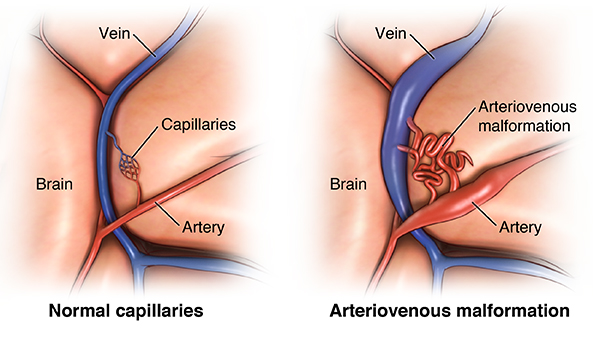What are the Risks and Symptoms of a Brain Aneurysm?
Who is at Risk of a Brain Aneurysm
You are more at risk for an aneurysm if you have one of the inherited problems below:
Alpha-Glucosidase Deficiency
This is a complete or partial lack of the enzyme needed to break down glycogen and to convert it into glucose.
Alpha 1-Antitrypsin Deficiency
This is a disease that may lead to hepatitis and cirrhosis of the liver or emphysema of the lungs.
Arteriovenous Malformation (AVM)
This is an abnormal link between an artery and a vein.

Coarctation of the Aorta
This is a narrowing of the aorta. This is the main artery coming from the heart.
Ehlers-Danlos Syndrome
This is a connective tissue problem (less common).
Fibromuscular Dysplasia
This is an artery disease that most often affects the medium and large arteries of young to middle-aged women.
Hereditary Hemorrhagic Telangiectasia
This is a disorder of the blood vessels. The blood vessels tend to lack capillaries between an artery and vein.
Klinefelter Syndrome
This is a condition in men in which they have an extra X chromosome.
Noonan's Syndrome
This is a disorder that causes abnormal development of many parts and systems of the body.
Polycystic Kidney Disease (PCKD)
This is a disorder that causes many fluid-filled cysts in the kidneys. PCKD is the most common disease linked to berry aneurysms.
Neurocutaneous Syndromes
These include neurofibromatosis or tuberous sclerosis. This is a type of neurocutaneous syndrome that can cause tumors to grow inside the brain, spinal cord, organs, skin, and bones.
Other risk factors linked to aneurysms may include:
- Advanced age
- Gender (more common among women)
- Alcohol use, especially binge drinking
- Atherosclerosis. This is a buildup of plaque in the inner lining of an artery.
- Cigarette smoking
- Using illegal drugs such as cocaine or methamphetamine
- High blood pressure
- Head injury
- Infection
These factors increase a person's risk. But they don't necessarily cause the disease. Some people with one or more risk factors never develop an aneurysm. Others develop the disease and have no known risk factors. Knowing your risk factors for any disease can help to guide you to change behaviors and be checked for the disease.
What are the Signs and Symptoms of a Brain Aneurysm?
You may not know you have a cerebral or brain aneurysm until it tears or ruptures. Most brain aneurysms have no symptoms and are small in size. Smaller aneurysms may have a lower risk for rupture.
In some cases, symptoms may happen before a rupture. This is because of blood that may leak. This is called sentinel hemorrhage around the brain. Some aneurysms also cause symptoms because they press on nearby structures. These can include nerves to the eye. They can cause vision loss or difficulty moving your eye even if the aneurysm has not ruptured.
The signs and symptoms of a brain aneurysm that has not ruptured may include:
- Headache located in one place
- Dilated pupils
- Blurred or double vision
- Pain above and behind either eye
- Weakness and numbness
- Trouble speaking
Ruptured brain aneurysms usually result in a subarachnoid hemorrhage (SAH). This is bleeding into the space around the brain called the subarachnoid space. A SAH can be life-threatening. Seek medical attention right away if you are having some or all of these symptoms:
- Sudden, very severe headache
- Loss of consciousness
- Nausea and/or vomiting
- Stiff neck
- Sudden blurred or double vision
- Sudden pain above or behind the eye or trouble seeing
- Sudden change in mental status or awareness
- Sudden trouble walking or dizziness
- Sudden weakness and numbness
- Sensitivity to light known as photophobia
- Seizure
- Drooping eyelid
Can a Cerebral Aneurysm be Prevented?
Controlling your risk factors may lower your risk of having an aneurysm. These risk factors include:
- Drinking alcohol (especially binge drinking)
- Atherosclerosis
- Obesity
- Cigarette smoking
- Use of illegal drugs, such as cocaine or amphetamine
- High blood pressure
- Head injury
- Infection
These factors increase a person's risk, but they don't necessarily cause the disease. Some people with one or more risk factors never develop an aneurysm. Others develop the disease and have no known risk factors. Knowing your risk factors for any disease can help to guide you into helpful actions. These include changing behaviors and being checked for the disease.